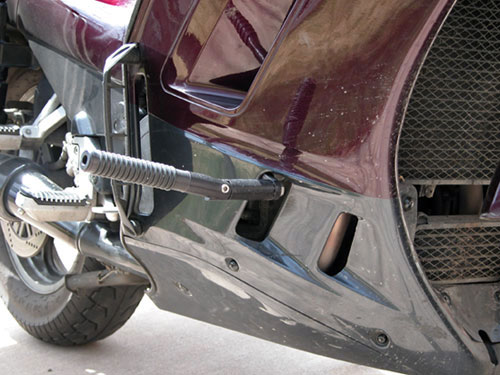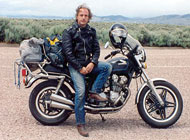In all the years I’ve had it I have never appreciated my electric vest more than I did Saturday, when I spent two hours in the lead of a bicycle race. To recap from my posting last week, I signed on to be a Motorcycle Lead for some bicycle races out at the little town of Deer Trail, about 50 miles east of Denver. As it turned out, it almost didn’t happen.
Saturday morning was chilly but sunny and I was prepared because the forecast was for possible rain or snow. I put on long underwear, my heavy boots, my electric vest, and plenty of layers. The cruise out to Deer Trail was extremely pleasant, and I felt like I would have loved to just keep on going, not stopping until I was somewhere in Kansas or Nebraska. I appreciated the Concours’s full fairing, too, because I knew my comfort had a lot to do with the protection it offered.
Arriving at the staging area for the races, they quickly outfitted me with a radio and told me what I would be doing. I headed for my bike and had not even gotten there when, over the radio, they called me back. On returning I was told they did not need me and other people needed the radio. Did I mind? “Not at all?” I asked. “Oh good, well thanks for coming,” she replied. “No,” I said, “that was a question. You don’t need me at all?”
Well, it turned out, they could always use Marshalls, where my job would be to just ride in front of the pack and be visible so motorists would recognize that a bike race was coming. Funny, that was what I thought I had signed on for. So I hustled off to the starting line and very quickly we were underway.
The course initially followed the frontage road along I-70, going out 8 miles to the Lowland exit and turning around, then turning around again in Deer Trail and right back out the frontage road, this time 12 miles to the Agate exit. From there it was back to Deer Trail again, through town and over to the other side of I-70 and out a ways, then a turn onto a county road, out 7 miles, and then return to the finish line. About 60 miles in all.
The first leg out was pretty brisk and I rode along at about 30-35 mph, with my eye constantly on the mirror. I had been warned to keep an eye on the riders because you never knew when someone would make a break and I needed to stay far enough ahead that they couldn’t draft off of me. Occasionally I was surprised to see how all of a sudden a small group of riders was indeed rapidly catching up with me, and I had to throttle up quickly to pull further ahead.
Turning around at Lowland and heading back, the entire situation changed. Suddenly we were facing a strong headwind, and it was cold. Obviously we had had the advantage of a good tailwind on the way out but now the tables were turned. For the 8 miles back to Deer Trail I had to get the knack of going very slowly. If I went 20 mph I would get too far ahead. I downshifted and worked at staying at about 15 mph, occasionally pulling in the clutch and coasting down to less than 10 mph, but even so there were times when I just pulled to a stop in the middle of the road and sat there and waited.
Then we got back to Deer Trail and turned around again, and once again it was a fairly high-speed ride the 12 miles out to Agate. By the time we got to Agate I was really in the lead of just a small group of riders who had left the rest of the pack pretty far behind. We turned around and once again the blast hit us in the face and once again it was a very slow ride back.
Nevertheless, by this time we were passing the lagging riders from the race that started out on this same course 15 minutes before our group. It was no problem when it was just one or two riders but I wondered how this would be managed when we came up on a large pack of riders to be passed. No problem, though, they know the routine. Perhaps alerted by my presence, the pack edged to the right to make way, I zipped past, and the lead riders behind me pumped up their speed and blasted past.
By the time we reached Deer Trail again there were only three riders behind me, and a support vehicle right behind them. We passed through town and over to the other side of the highway and out the county road. At this point we were moving directly perpendicular to the wind, and it was brutal. On top of that, it was starting to blow snow. Even these top riders, who had now ridden more than 40 miles already, could only manage about 15 mph, although on a couple downhills I once again had to goose the throttle to stay out in front.
At this point I was ever more thankful for my electric vest but I was still getting pretty darn cold. On top of that, with the side-wind, my fairing was not doing a lot of good and the body work on the Concours was acting like a sail, making it hard for me to stay on the road, especially at 15 mph or less. Some of the bicyclists were actually being blown off the road.
Half way out to the last turnaround point, there were only two racers behind me. We turned and headed back in and as we drew nearer to the finish line these two guys, who had now ridden more than 50 miles in horrible conditions, started to sprint. I crossed the finish line at 30 mph with them right behind me and I just kept on going, straight back to the staging area and relative warmth.
Then a funny thing happened. As long as I was on the bike with the electric vest providing heat I was cold but not horribly so. As soon as I got off the bike and no longer had the vest to provide heat, I started to shake and shiver horribly. I know that feeling, I’ve experienced it before: hypothermia. Lunch was waiting, hot coffee, but no heat in the building. I know coffee is not a good thing to drink for hypothermia but it was all they had. So I ate and drank and shivered for about 45 minutes.
While I ate I talked with another guy who was one of the referees, who did his work on a motorcycle, too. He had a full Aerostitch suit, electric vest, heated grips, and all on his BMW, and he was just as cold as I was. He said he’d been doing this for years and this was the kind of day he dreaded. He was just glad it was snow and not rain, because you get a lot wetter in the rain.
When asked if I would be working the afternoon races I politely declined. Too cold! I collected my check and headed to the nearest convenience store and went inside where it was warm and got a big cup of hot cocoa. Finally when I was no longer shaking I got back on the bike and headed home, passing through intermittent snowfall along the way. At home I took a hot shower for about half an hour.
So the question is, will I work the second race that I initially signed up for, in Hugo in about a month? I can’t really say at this point. I could use the money, and the weather ought to be a lot nicer. We’ll just have to see.
Biker Quote for Today
Good coffee should be indistinguishable from 50 weight motor oil.

